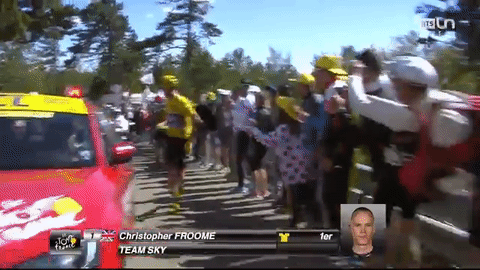A favourite hobby among people who work in financial services is wild speculation. Since everyone is getting excited for another Tour de France, we thought we’d look ahead and think about what our sport might look like in ten years time.
Metal fencing up the iconic climbs?
Sadly there is no climb up Ventoux in the 2017 route, but it is a regular feature, and the scrum up the mountain in 2015 illustrates the problem. Incidents involving spectators (and their dogs) interfering with riders or knocking riders off entirely are on the rise. Combine this with increasing security fears in Europe, and the introduction of more and more barriers seems inevitable.
It’s hard to see how the organisers could go about fencing in supporters along the entire three and a half thousand kilometres of the Tour de France, but on famous sections such as Ventoux it is a real possibility. Over the next few years, a cheeky clip round the ear might not be enough anymore.
Arguably, the spectators aren’t the real problem here. The crowds have always been deep and enthusiastic, and while there are occasional collisions, on the whole people move out of the way when they see the riders coming. What has changed over the years, is the number of other vehicles surrounding the riders.
There might be plenty of space on the roads for all of the spectators while an attack makes its way up the mountain, but add in an army of motorbikes fighting over Chris Froome close-ups and it becomes a recipe for disaster. Perhaps a much better option would be to ditch the motos.
No more Motos
Motorbike cameras are hateful things that spoil races for riders and spectators. Nobody is going to forget the sight of the gangly-armed Chris Froome jogging up Mount Ventoux in a hurry.

We’re in a bit of a catch 22 situation unfortunately. As more people tune in to watch the tour, sponsors are willing to invest more into the teams and broadcasters to give more airtime. In return they want their footage to be up close and exciting, so if we are going to ditch the pillion cameramen, we are going to need some compelling alternatives.
On board cameras
One of the highlights of the last couple of years was watching the Giant-Alpericn’s in-peloton footage uploaded to their YouTube channel after each major race. We’ve all ridden in groups, but to experience travelling at that speed in such a tight bunch of riders -even if it is via the medium of a fish eye lens- is remarkable.
Recent track events at the Lee Valley Velodrome such as the London 6 Day and UCI Track Cycling World Champs have had live GoPro footage up on the big screens around the track, and incorporated into the television footage. The technology already exists, so surely it wouldn’t take a whole lot of tinkering to get on board footage included in the tour coverage next year, let alone in ten years time?
Unfortunately, things move at a very slow pace in cycling off the bike, particularly when you’re talking about the Tour de France.
Currently, nobody can quite agree to who would own the footage. The teams think it should belong to them, the Amaury Sport Organisation (ASO) would like to claim the footage, and each of the distributors and broadcasters would like to put their claims in too. I can’t see how you are going to get onboard cameras past Team Sky’s ‘marginal gains’ regime, and the UCI have no motivation to make on bike cameras compulsory in the rules.
On board cameras are here, working, now. But don’t be surprised if it takes us another 10 years to get them included in the televised footage.
Drones
Obviously drones. You can’t have a future speculation article and not talk about drones.
Drones have just begun to make an appearance in live and recorded televised events. They have been used for a couple of years to stream crowd footage at big festivals, and in the latest 90’s flashback, the reboot of Robot Wars over in America has had success using drone footage to get up close and personal with the terrifying new machines.
10 years ago the technology in modern quad copters was almost unimaginable. They use super accurate GPS, accelerometers, and in some cases optical sensors and radar, all pumped out to the rotors via a microprocessor in order to hover stable and still. You might feel like you are flying a drone, but all you’re really doing by moving the sticks is asking it nicely to fly somewhere, and watching the drone kindly oblige you.
With Elon Musk spending his billions on making better batteries, and companies like Google and Apple investing in electronics for their smartphones and AI for their battledroids autonomous cars, it’s amazing to think how these drones will progress in the next ten years. Their props are sharp and spin very quickly, but I’d much rather have one of those crash into me than a motorbike with two guys on the back.
Perhaps in ten years time we will be able to watch the cycling from the perspective of tiny, autonomous wasps, actively avoiding riders as they nip in and out of the peloton, and giving chase on the descents.
Looking to brush up on your trivia before the next race? Check out our Tour de France Infographic.